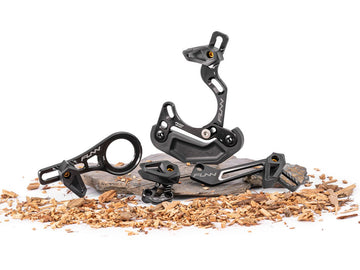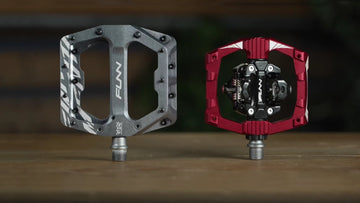If you love biking, you know how important it is to have a good headset. This small part is super important for making your bike handle well and turn smoothly. It connects the top part of your bike (the frame) to the front part (the fork). However, with various bike headset types available, choosing the right one can be complex.
That’s where the Standardized Headset Identification System, or S.H.I.S., comes in. It’s like a special code that helps you figure out and simplify the process of matching the right bike headset type to your bike. With the S.H.I.S., you don’t have to guess anymore – you can find the perfect fit easily.
What is a Bike Headset Used for?
At its core, a bike headset is a component that provides a rotatable interface between the bicycle fork and the head tube of the frame. The type of headset determines how the handlebars and front fork are connected and how they move relative to each other.
Before the advent of the S.H.I.S., the market was flooded with various bike headset types, each differing in dimensions and designs, making compatibility a significant challenge.
What does S.H.I.S. Stand for?
The Standardized Headset Identification System (S.H.I.S.) represents a significant advancement in the cycling world, especially when it comes to understanding and categorizing bike headset types. This system was developed to bring a sense of uniformity and clarity in an area that was previously marked by confusion due to the wide variety of headsets available. By standardizing the nomenclature, S.H.I.S. has made it easier for cyclists, manufacturers, and retailers to communicate about headset specifications.
The system primarily uses three key parameters to categorize bike headset types: the design type, the outer diameter, and the inner diameter. Each of these parameters plays a crucial role in determining the compatibility and functionality of the headset with the bicycle’s frame and fork.
What are the Different Types of Headset Bearings?
This aspect of the S.H.I.S. code refers to the physical structure and the mounting style of the headset. It indicates how the headset will fit into the bike frame, which is essential for ensuring that the headset is compatible with the bike’s design. The design types commonly found in the S.H.I.S. system include:

IS (Integrated System):
The Integrated System design is where the bearings sit directly in the frame, like our Descend-Integral, eliminating the need for cups. This results in a very low stack height and a clean, integrated look. It requires precise frame manufacturing, as the frame itself forms the bearing surface. This design is often favored for high-end bikes where aesthetics and weight savings are priorities.
ZS (Zero Stack):
The Zero Stack, or ZS, design features bearings that sit inside the frame to a significant extent. This setup allows for a lower profile, reducing the stack height and contributing to a sleeker appearance of the bike. It’s a popular choice for modern bike designs seeking a minimalist look. An example from our product range is the Descend ZS Model.
EC (External Cup):
In this design, like our Descend EC model, the bearings sit in cups that protrude externally from the frame. This traditional style is known for its durability and ease of maintenance. It’s suitable for bikes that require a robust headset capable of handling larger bearings.
Decoding the S.H.I.S. Code
Understanding the S.H.I.S. code is key to mastering bike headset types. Let’s take an example from the common S.H.I.S. code in the Funn Descend model: ‘ZS44/28.6 | EC44/40’. This code might seem cryptic at first, but it’s quite straightforward once broken down.
What is ZS44/28.6?
The first part of the code ZS44/28.6 refers to the upper part of the headset. “ZS” stands for Zero Stack, indicating a specific design type where the bearing sits inside the frame to a large extent, reducing the stack height. “44” is the headset outer diameter in millimeters, indicating the size of the head tube where the headset will be fitted. “28.6” refers to the inner diameter of headset bearing, which matches the outer diameter of the steerer tube (Stem Clamp Diameter).
What is EC44/40?
The second part of the code EC44/40 describes the lower part of the headset. “EC” stands for External Cup, a design where the bearing sits in a cup that protrudes outside the frame. “44” again is the headset outer diameter for the lower part of the frame head tube, and “40” is the inner diameter of headset bearing to accommodate the lower part of the steerer tube (Crown Race Seat Diameter).

Choosing the Right Bike Headset Type: A Measurement Guide
Now that we’ve grasped the concept of S.H.I.S., let’s explore how to select the appropriate headset specification using our measurement results.
Checking Manufacturer Specifications:
Before proceeding to measure the frame and fork dimensions for your headset, it’s often helpful to first consult the bike or frame manufacturer’s specifications. These specifications typically provide recommended headset sizes. They can also serve as a reference to ensure that your measurements align with the manufacturer’s intended design. By cross-referencing these specifications with your own measurements, you can confidently select a headset that matches both the manufacturer’s guidelines and the specific dimensions of your bike.
Frame Headtube Inner Diameter:
In the absence of guidelines from the frame manufacturer, you can still accurately determine the suitable headset sizes by directly measuring the diameters of both the frame and fork. Let’s start by measuring the inner diameters of the frame’s head tube. This dimension is important because it establishes how the headset will fit inside the frame, and it determines the outer diameter of the headset.

Once you have obtained the measurement results, you can use them to reference the table provided below. This table will help you match your measurements with the corresponding headset size expressed in SHIS (Standardized Headset Identification System) values.

Steerer Tube Outer Diameter:
After determining the headset’s outer diameter, the next step is to measure the outer diameter of the fork’s steerer tube, which will define the inner diameter of the headset. This involves measuring the upper section of the steerer tube as well as the crown race section at its base. The measurement of the upper section will help you select the right upper headset, while the diameter of the crown race decides the lower headset size.

Modern mountain bikes typically feature one of two types of fork steerer tubes. The first type is the straight steerer fork, characterized by a uniform outer diameter along the steerer tube, usually 28.6 mm. This design is frequently found in traditional and entry-level bikes. Headsets for these forks tend to be simpler, requiring only a single diameter fit.
The second type, the tapered fork, has gained popularity in performance-oriented bicycles, including mountain and road bikes. Tapered forks have a steerer tube that narrows from a larger diameter at the bottom to a smaller diameter at the top. Typical measurements for these are 28.6 mm at the top and 40 mm at the crown. The advantage of the tapered design lies in its increased stiffness and strength, which translates into better handling and responsiveness for the rider.
Below is a table that outlines the common SHIS sizes found in mountain bikes, helping you identify the appropriate headset size for each type of fork steerer tube.

By integrating the bike headset type with both the outer and inner diameter measurements, you can determine the specific S.H.I.S. specification for your bike. This allows you to accurately identify the corresponding upper and lower headset sets tailored to your bicycle’s requirements.
Conclusion
The introduction of the Standardized Headset Identification System (S.H.I.S.) has significantly simplified the process of selecting headsets. This system provides a clear and standardized approach to finding headsets that are not only compatible but also efficient and reliable, catering to a wide range of bicycle designs. I hope this blog proves helpful in guiding you to select the ideal headset for your bike.






